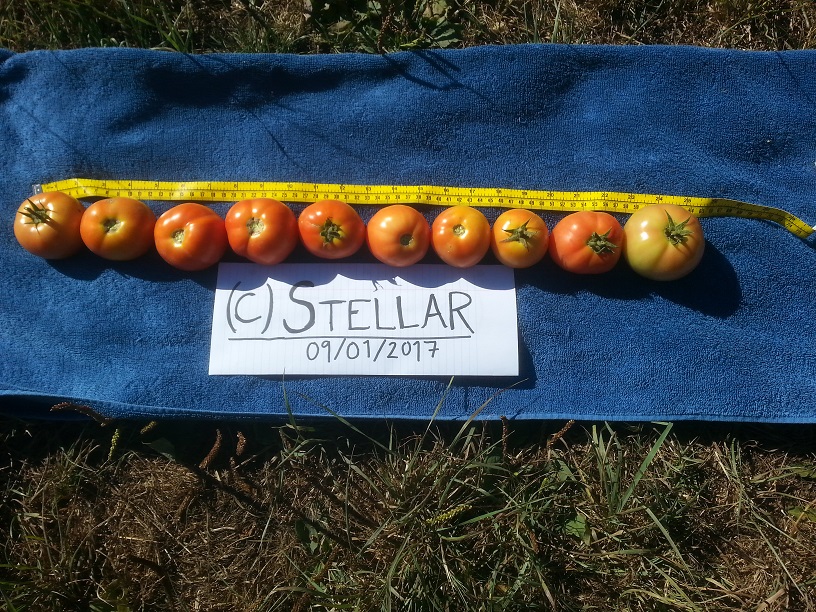A medium-sized, determinate, red, slicing tomato carried by PanAmerican Seed, who describes this F1 hybrid as “the perfect slicer for areas with high disease pressure.” The company lists Stellar to have high resistance to Fusarium race 2, late blight, and Verticillium, and intermediate resistance to early blight and Septoria leaf spot. Apparently though, this variety’s disease resistance is strongest when planted away from other tomato varieties – that doesn’t happen so much in a randomized complete block design, especially one this small.
Truth be told, Stellar is not living up to its name in the trial (and hasn’t really since the beginning). It has scored as some of the most severe in terms of disease, including the plot in Block 1 which are practically dead. The plants are spindly, the fruit is rather small and inconsistent. It scored low in leaf curl and high in leaf cover, so we are also having trouble with soft rot on the fruit now that the weeds have grown up, our nights are cooler, and the mornings foggy. Stellar has been in the middle-bottom of the pack at just about every evaluation.
If Stellar has any redeeming characteristics so far, it does ripen fairly early, especially for a determinate. In fact, along with Mt. Merit, Stellar was the only variety to be grouped with any indeterminate variety after running ANOVA and Tukey’s HSD on the first ripe fruit data. In terms of sensory evaluations, Stellar has been well-received for those that enjoy a juicy and acidic tomato. At this point, I’ve eaten several Stellar fruits at different times. They are variable. I like an acidic tomato (great for curries and Thai-inspired dishes), and the good Stellar fruits are lovely. But I’ve also eaten some that were no better than the average grocery store tomato. With all considered, I agree with Connor’s conclusion on Stellar F1: “unstellar.”
First Ripe Fruit:
| Block 1 | Block 2 | Block 3 |
| August 18 | August 25 | August 10 |
All harvest data represents two Stellar plants from each block, or six plants total:
Harvest 1 (August 25, 2017)
Picking Ease (5=easy, 1=difficult): 5
Marketable Fruit: 6 fruit weighing 602g (1.33 lb.) Unmarketable Fruit: 8 fruit weighing 323g (11.4 oz.)
Reasons why unmarketable: too small
Harvest 2 (September 1, 2017)
Picking Ease (5=easy, 1=difficult): 4
Marketable Fruit: 12 fruit weighing 1308g (2.88 lb.) Unmarketable Fruit: 12 fruit weighing 545g (1.2 lb.)
Reasons why unmarketable: scabbing, too small
Average Fruit Size: 6.4 cm x 5.81 cm (2.5″ x 2.29″)
Brix: 7.7, 7, 4.6
Harvest 3 (September 8, 2017)
Picking Ease (5=easy, 1=difficult): 2
Marketable Fruit: 15 fruit weighing 1505g (3.32 lb.) Unmarketable Fruit: 9 fruit weighing 452g (1 lb.)
Reasons why unmarketable: scabbing, too small
Harvest 4 (September 15, 2017)
Picking Ease (5=easy, 1=difficult): 4
Marketable Fruit: 17 fruit weighing 2440g (5.38 lb.) Unmarketable Fruit: 17 fruit weighing 1147g (2.53 lb.)
Reasons why unmarketable: soft rot, too small
Harvest 5 (September 22, 2017)
Picking Ease (5=easy, 1=difficult): 3
Marketable Fruit: 18 fruit weighing 1657g (3.65 lb.) Unmarketable Fruit: 19 fruit weighing 1046g (2.31 lb.)
Reasons why unmarketable: soft rot, too small, scabbing

Leave a Reply